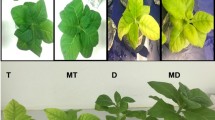Summary
Plant water potential, osmotic potential, stomatal resistance, leaf temperature, soil temperature, height, dry weight, and nutrient composition of winter wheat (Triticum aestivum L. em. Thell. ‘Osage’) grown with electromagnets 10 cm long were measured to determine the effect of magnets on water relations, temperature, and growth. Plants grew in 15-cm diameter pots in a growth room for 44 days with the magnets, which had 0, 5, 15, 25, 50, 125, or 250 ampere-turns. Plants grown with few ampere-turns (5–25) had higher water and osmotic potentials, lower stomatal resistances, were taller, had a higher dry weight, and a higher nitrogen concentration than control plants or plants grown with many ampere-turns (250). Leaf and soil temperatures of controls tended to be less than those of plants and soil with magnets. Calculations showed that magnets with 5–25 ampere-turns and 50–250 ampere-turns generated 0.86 and 0.43 cal/s, respectively. The latter value agreed with the measured increase in temperature (0.5° C) for soil with 250 ampere-turns. The data indicated that the increased height and dry weight of plants with 5–25 ampere-turns were due to soil heating caused by the magnets and heat produced by the 50–250 ampere-turns was not enough to stimulate growth.
Similar content being viewed by others
References
Boe AA, Do JY, Salunkhe DK (1968) Tomato ripening: effects of light frequency, magnetic field, and chemical treatments. Econ Bot 22: 124–134
Bogatina NI, Berkin BI, Kulabukhov VM, Litvin VM, Nikulina VF (1979) Threshold of wheat seedling and root sensitivity to magnetic field strength. Soviet Plant Physiol 26: 497–500
Chapman HD (1973) Diagnostic criteria for plants and soils. 2nd printing, Quality Printing Co., Abilene, Texas, pp 570–728
Dawes CL (1939) Industrial electricity. part I, 2nd ed. McGraw-Hill, New York London, pp 130–144
Dubrov AP (1978) The geomagnetic field and life. Geomagnetobiology. Transl. from Russ. by F.L. Sinclair. Plenum Press, New York London, p 318
Kirkham D (1964) Soil physics. In: Te How V (ed) Handbook of hydrology. McGraw-Hill, New York, 5–1 to 5–26.
Kirkham MB (1980) Efficiency of drought-resistant and drought-sensitive wheat cultivars in the use of elements in soil. Phyton 38: 137–146
Kirkham MB, Ahring RM (1978) Leaf temperature and internal water status of wheat grown at different root temperatures. Agron J 70: 657–662
Krylov AV, Tarakanova GA (1960) Magnetotropism of plants and its nature. Sov Plant Physiol 7: 156–160
Lehenbauer PA (1914) Growth of maize seedlings in relation to temperature. Physiol Res 1: 247–288
Murr LE (1966) Plant physiology in simulated geoelectric and geomagnetic fields. Adv Frontiers Plant Sci 15: 97–120
Pauling L, Coryell CD (1963) The magnetic properties and structure of the hemochromogens and related substances. Proc US Natl Acad Sci 22: 159–163
Shortley G, Williams D (1971) Elements of physics, 5th ed. Prentice-Hall, Englewood Cliffs, New Jersey, pp 947, + appendix
Willis WO, Larson WE, Kirkham D (1957) Corn growth as affected by soil temperature and mulch. Agron J 49: 323–327
Author information
Authors and Affiliations
Rights and permissions
About this article
Cite this article
Kirkham, M.B., Hartmann, G.H. Water relations, temperature, and growth of wheat grown with magnets. Radiat Environ Biophys 20, 137–144 (1982). https://doi.org/10.1007/BF01323934
Received:
Accepted:
Issue Date:
DOI: https://doi.org/10.1007/BF01323934



